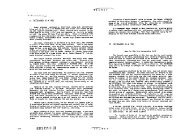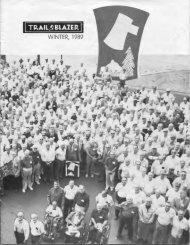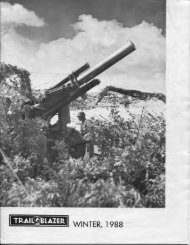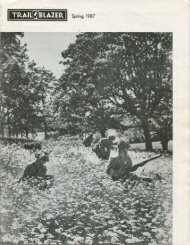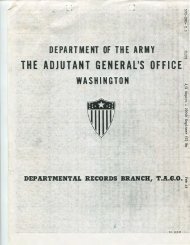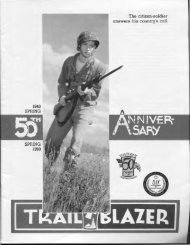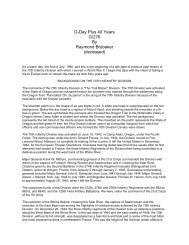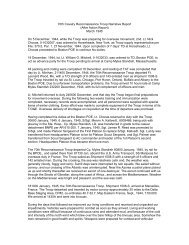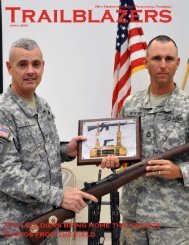TAKING THE SALUTE-S/Sgt. Frank Colla (nearest camera)and Pfc Ernest Day, Co. G, 275th, werehonored at the <strong>Division</strong>'s first formalretreat parade on German soil. They1945ContinuedThe 275th's 3rd Battalion then moved out ofEtzling and hastily dug in on the lower slopes ofthe height Pfaffenberg. Farther east the 2ndBattalion had pushed into Grosbliederstroff.By mid-morning the German defenders hadbeen forced back to the northern end of thetown . The Battalion's attack was continued,troubled by artillery and mortar fire from theother side of the Saar River. Finally the lastGerman strongpoint in the town fell in a sharpfirefight.On the divisional left flank , the 276th stillconfronted the key defenses around Oeting.During the night it had cleared the mines fromthe road into that village. Then the Regimentresumed its attack on February 18. By earlyafternoon Oeting had been taken and a smallenemy infantry-tank counterattack was repelled. Afterwards the Regiment turned itsfront to the northwest toward Forbach.In its path rose three hills covered by thethick woods of Kleinwaeldchen . The westernmostof the three hills rose sharply from theforest to afford a panoramic view of Forbach tothe north and visibility to the south as far asOeting. On its summit stood a redstone castle,the Schlossberg. The commanding observationgiven to the side that held it made the capture ofthe Schlossberg the obvious prerequisite to thetaking of Forbach.By nightfall on the 18th two of the three hills8had just been awarded the Bronze Star.This photo by Chet Garstki ran in the first"Trail blazer" that had been cleared bycensors so it could be sent home. Thisran on April 5, 1945.in the Kleinwaeldchen had been overrun. Thenext morning Co. I advanced cautiously towardthe Schlossberg. Surprisingly, no opposingenemy fire was encountered and, when theattackers scaled the outer walls, they found thecastle deserted . Almost immediately heavy artilleryand mortar fire began falling in the area.Between barrages the troops dug in around thebuildings.At 7:20 p.m. an enemy battery of 88mmguns began shelling the castle with great accuracy.Under this covering fire , German patrolscrept up to the outer perimeter of thecompany's defenses and cut its telephone wire.At 8:40p.m. the enemy artillery barrage wasbriefly intensified. Then as it was lifted, Germaninfantrymen began rushing the castle fromthree sides, screaming wildly. Despite Co. I'sactive resistance with rifle fire, the enemyadvance reached to within yards of the castle.When he judged that the attacking Krautswere sufficiently close, the Co. I commanderCapt. Herbert J . Andrews had his men calledfrom their firing positions to shelter inside thecastle walls and requested defensive artilleryand mortar fire. Thirty-five dead Germanswere found on the hill around the castle the nextmorning.The shelling that came in response-8lmmmortar frre of Co. M. and I 05mm howitzer fireof the 884th Field Artillery-drove the enemyback. The vital Schlossberg position remainedin American hands .Supported by the 274th's 3rd Battalion, the276th assault in Forbach began late the sameafternoon, February 19. The road from Saarbrueckento Forbach, the Metz Highway, wasto be interdicted by attack aircraft. The 276th's1st Battalion and elements of the 3rd Bn. 274thwere the first units to penetrate into the city inits southeast section. The enemy opened upwith machine-gun and artillery fire on the advancingskirmishers after they had penetratedthrough the first two blocks. When the advancewas thus slowed, 3rd Bn , 276th less Co. I,descended from the Kleinwaeldchen and joinedin the house-to-house fighting . The attack continueduntil shortly after nightfall.*In its "Report of Operations" for February19, the Seventh Army G-3 staff evidently foundnothing noteworthy in 274th activities. However,there was a dramatic event involving theregimental commander that day. Reconnoiteringthe heavily wooded, rough terrain onKreutzberg ridge, Col. Sam Conley and hisparty including Maj. Buford Boyd, 2nd Bn.CO, came fact to face with a trench full ofenemy infantry. Conley and his party seemedtrapped when the enemy opened fire . But thenthe colonel made a run for it to get help and gotout amid a hail of enemy automatic weapons.Lt. Fred Cassidy was with one of his Co. G rifleplatoons when it received a radio message ofthe command group's predicament. Runningforward to investigate, Cassidy ran into Conleygoing the opposite way. After a brief discussion,Cassidy fetched the same platoon,found a supporting tank, climbed on its back,and directed his ad hoc task force throughtangled woods, over barbed wire and to therescue. After a brief, hot fight 50 Kraut prisonerswere taken.DAYBREAK on February * 20 was attendedby drizzling rain and fog , restricting tankmovement to roads and making displacementof artillery difficult. The <strong>70th</strong> ReconnaissanceTroop in its patrolling concentrated on theeastern flank, where the advance of the adjacent63rd <strong>Division</strong> had lagged behind that ofthe 275th <strong>Infantry</strong> across the Sarre River. The275th's 1st and 2nd battalions advanced rapidlyagainst light resistance, capturing the villagesof Zinzing, Hesseling, and Alsting.T!Sgt. Rorabaugh: "After A/sting wascleared on the 20th, we immediately pushed oninto the woods beyond and ran into stiff resistence.We cleared out some pillboxes and tooksome prisoners. Among them was a medicwearing a white over-vest with its big redcross. He did a great job administering first aidto wounded men from both sides. I remember aGerman officer had been shot between the eyeswhile looking through his binoculars. We usedthe fit prisoners as litter bearers."Sgt. Lee Miller, Co . D, 275th: "We had afine gun position south ofZinzing. On the firstnight of preparing it we had to lie in snow as wefilled sandbags; then before dawn we put thebags in the hole we'd excavated and camouflagedeverything with snow before withdrawing.After a couple of nights working like thiswe had a bunker with a 4"-by-4" timber roofcovered by several layers of frozen dirt. Theday before the jump-off the weather thawed,and the bags sagged under the weight of theroof, making our position unusable. We had torebuild the whole thing .''<strong>70th</strong> <strong>Division</strong> Assn. TRAILBLAZER
After a small counterattack east of Zinzingwas dispersed, the two 275th battalions fannedout into the wooded areas to the north and east.However, on their left the 3rd Battalion's attemptsto drive the enemy off the height Pfaffenbergwere initially unsuccessful.Co. I, 275th "Record of Events" : " In theafternoon the Company attacked the highground north of Etzling and took it with ftxedbayonets. Casualties were not so light due toour own artillery and enemy mortars, artillery,and snipers. After digging in at a positionlooking down the throats of enemy in Spicheren,the Company threw back a counterattack.Our artillery continues to give the H einieshell. S!Sgt. Fulcher was killed and 12wounded were evacuated. Three men werewounded but not evacuated. '' (Note: There is astriking difference in the two preceding accountsof the same action-a not unusualdiscrepancy in wartime records.)Lt. Ted Heck: "A Jew days before, I hadtaken a flight over the front lines in a Divartyliaison plane-part of a program to familiarizeS-2 personnel with the terrain and front-linetroop dispositions. On the day of the attack onPfaffenberg, I suggested to my battalion commanderthat I again fly over the action andradio down information on enemy troop deploymentsaffecting the Battalion' s assault.Given the okay, I and my pilot were drawingfire a thousand feet above the action when theassault began. Our pinpointing of enemystrongpoints was given credit in the success ofthe attack and for the lightness of casualtiestaken.''Lt. Lawrence DuBose, * Co. L, 275th: " TheCompany' s advance took it across severaltrenches and a tank-trap ditch. There was some88 shelling but no one was hit. Unfortunatelywe became involved in afirefight in the wet andfog with our K company; Sgt Bridges wasseriously wounded and several others receivedflesh wounds. Except for getting wet, nothingwas accomplished, and we withdrew to Etzlingin the afternoon. (Note: DuBose's recollectionof the clash between two friendly companies ismore consistent with G-3 account of the 3rd Bnassault on Pfaffenberg.)In Forbach the slow, systematic reduction ofthe city continued. Assaulting troops of the I stand 3rd Battalions, 276th <strong>Infantry</strong>, advancedalong the streets toward the railroad on thenorthwestern edge of town forcing the enemyback house by house and block by block. Whenthe enemy was forced to abandon any defensiveposition, his artillery and mortars pounded thearea just given up heavily with mortars andartillery.At this time the German 347th <strong>Infantry</strong> <strong>Division</strong>forces defending Forbach were receivinglocal Volkssturrn replacements and an additional300 infantrymen from the 719th <strong>Infantry</strong><strong>Division</strong>, which was defending a nearby sectoragainst the American Third Army."<strong>70th</strong> <strong>Division</strong> Story": "The Simon Mineand Factory at Forbach was surrounded by adeep anti-tank ditch and a 7-foot wall surmountedwith iron spikes laced with barbedwire. In a charge to penetrate the compound bya Jrd Battalion rifle platoon, only one manreached the wall. Crawling through a hole, hewas advancing beyond the wall when he washit. S!Sgt. Joseph Kohn , a medic with theplatoon, saw the man fall. Kohn advancedthrough enemy fire across the open ground andthrough the wall to reach the man and carryhim to safety. Kohn was awarded the SilverStar and received a battlefield commission."Silver Star citation for Pfc. Willie J. Daigle,Co. E, 276th: ''As the scout for the squadspearheading an attack on strong enemy posi-For Sale:One bookThe <strong>70th</strong> <strong>Division</strong> "HistoryBook" reached the men whohad ordered it just about thetime the last issue of the "Trailblazer"did. Response has beenexcellent.A few copies remain. Theywill be sold on first-come basisfor $48, which includes postage.Please send your checkwith your order to:Orville Ellis9255 Birch Tree LaneSt. Louis, MO 63126lions, Sergeant (then Pfc.) Daigle skillfullymaneuvered under enemy fire and cut throughthree rows of barbed wire entanglements toopen gaps through which the assault teamsgained entrance to Forbach. Later he deliberatelyexposed himself to engage an enemysniper in afirefightto enable medics in crossinga street exposed to the sniper's fire and inevacuating several casualties from there.''Meanwhile, 274th units operating just eastof Forbach worked their way to within a shortdistance of the Forbach-Sarrbruecken road(Metz Highway) and other 274th troops sweptnortheast to high ground between Spicherenand Stiring Wendel. Spicheren Heights northof Spicheren was to become an area of particularlybitter German resistance.The editor just has to say ....It is by intent that there are no responses in this issue toCasey Cassidy's challenge to the officiai"Narrative Report"of the 276th's action at Wing en and other places during<strong>January</strong> 1945. Old soldiers are supposed to argue and tobrag about who really won the war. But I was afraid ourdebate was verging on acrimony.I don't think arguments should ever challenge veracity,sincerity or fraternity. We are all Trail blazers; we all sharethe victories and the honors and the achievements of allother 'Blazers.It is important to understand how the historical material inthis magazine is written. I wrote the reports on the threeregiments, concentrating on a specific month for each one.Charlie Pence, of course, wrote the material on this pageand the similar account in the last issue.Each of us used as sources, official records which we haveno reason to doubt. Neither of us has an axe to grind; weare simply reporters of the truth as we can find it.But there will always be differences in interpretation andeven acknowledgment of facts. I remember Bob Cheves, aman for whom I held highest regard and affection, telling methat I had the facts wrong, that our troops had never pulled<strong>January</strong>, <strong>1986</strong>out of Strasbourg during the Bulge. I knew different. RobyWentz, of the old ''Trailblazer'' staff, and I had walked thetotally deserted streets and found only a small detachmentof "Stars & Stripes" men there. They described the pull-outthat left the city vulnerable. Bob later on unearthed moreinformation and, as always, was gracious enough to admitthat he was wrong. Perhaps each of us is entitled to his own"history" of action that he was in.On behalf of Charlie Pence, I point out that he is writing asa historian of repute and author of the estimable book"Ordeal in the Vosges." He is totally impartial and has neverwritten from the viewpoint of his Co. B, 275th. I have had toedit his copy a little but only to make it fit, never to change hispresentation. It's because of my editing that some personalaccounts that Charlie had solicited were not run. They willappear in some later edition.As an editor, I am blessed with far more material than Ican squeeze into 16 pages. As a matter of fact, I have fourpages already set for the next issue. So if your contributionhasn't appeared in print yet, please be as patient as myprinter is.Edmund Arnold, editor9



